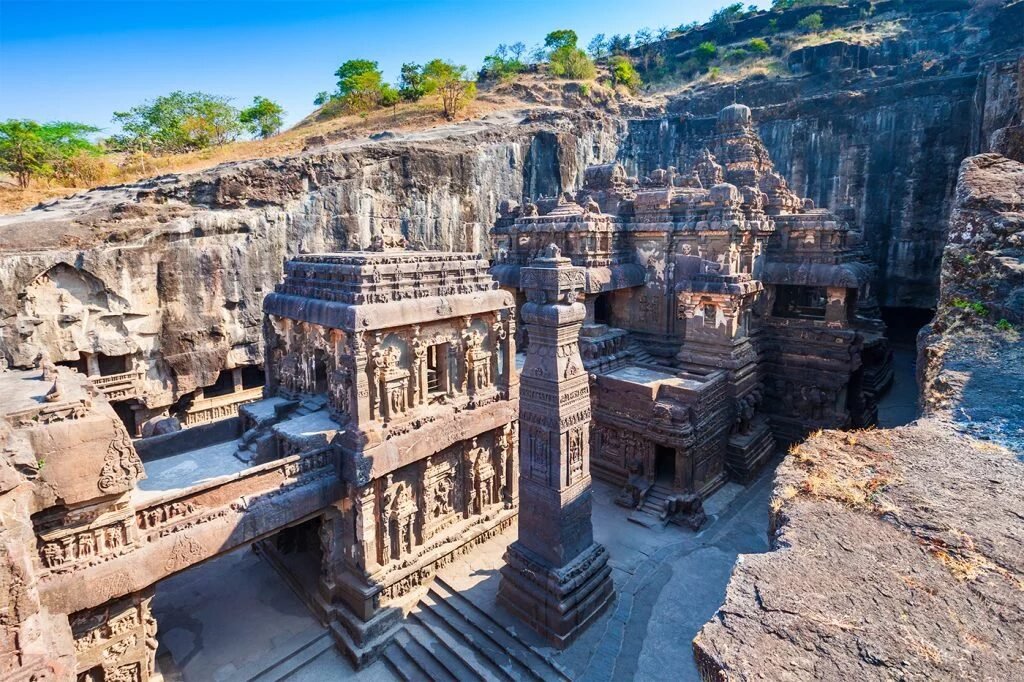One Stone No Joints The Unbelievable Kailasa Temple
Welcome to the Kailasa Temple at Ellora, India’s monolithic masterpiece and a testament to architectural genius shaped in solid basalt. With every detail etched from the living rock, it remains one of the few places where devotion, engineering, and artistry merge seamlessly.

About the Temple
Carved during the 8th century CE under the patronage of Rashtrakuta King Krishna I (r. 756–773 CE), the Kailasa Temple (Cave 16) was meticulously sculpted from the top downward—an unprecedented approach in temple construction.
-
Scale & Material: A freestanding, multi-storied structure carved from a single basalt cliff, estimated to have involved the removal of 200,000 to 400,000 tonnes of rock.
-
Size: Nearly twice the size of the Parthenon in Athens and with a courtyard footprint of about 82 m × 46 m, and height reaching 32 m.
-
Inspiration: Designed to evoke Mount Kailash, the mythical abode of Lord Shiva. Its courtyard, gateway (gopuram), assembly hall, sanctum, and spire all mirror the cosmic mountain.
-
Architectural Style: A distinctive blend of Dravidian (South Indian) styles with Chalukya and Pallava influences—likely the result of cross-regional craftsmanship.
-
Legends: A legendary architect named Kokasa is credited with carving the temple, his tale rooted in local folklore and medieval texts
Location & Visitor Information
-
Where: The temple is nestled within the Ellora Caves complex, near Aurangabad, Maharashtra (approx. 30 km away)
-
Entry Fees:
-
Indian citizens: ₹40 per person
-
Foreign visitors: ₹600 per person
-
Admission includes access to all Ellora Caves, of which there are 34 (Hindu, Buddhist, and Jain)http://The Viral Express.
-
-
Best Time to Visit: October to March—pleasant weather and clearer views. Avoid the monsoon months, when access can be tricky.
-
Access: Day trips to Ellora are common from Aurangabad, with local transport and guided tours available. Entry includes access to all cave groups.
Best Architectural Features
1. Entirely Carved from a Single Rock
-
No bricks. No joints. The entire temple, including walls, towers, pillars, statues, and pathways, was carved top-down from one massive basalt cliff.
-
This technique—vertical excavation—is rare and extremely difficult, requiring precise planning and masterful skill.
2. Largest Monolithic Structure in the World
-
The Kailasa Temple is the largest monolithic rock-cut temple in the world.
-
An estimated 200,000 to 400,000 tons of rock was removed—by hand, using only chisels and hammers.
3. Symmetrical, Multi-Level Design
Despite being carved out of a single rock, the temple has multiple levels, staircases, courtyards, shrines, and balconies—all perfectly symmetrical.
The temple complex includes:
- Main Shiva shrine with Shikhara (spire)
- Nandi Mandapa (bull pavilion)
- Bridges connecting pavilions
- Secondary shrines and sculptures
4. Dravidian Architecture with Fusion Influence
It follows the Dravidian style (seen in South India), but with influences from Pallava and Chalukya designs.
Features include:
- Pyramidal Shikhara (tower)
- Ornate mandapas (pillared halls)
- Gopuram-like entrances
5. Intricate Sculptural Work
The temple walls are covered with carvings of gods, goddesses, animals, mythical scenes, and epics like:
- Ramayana
- Mahabharata
- Ravana shaking Mount Kailash
- Shiva in cosmic poses
6. Engineering Genius of Ancient India
-
Zero use of modern tools.
-
Precise geometry and planning show advanced understanding of math, structure, and spatial awareness.
-
The temple layout resembles a built structure, but was actually hollowed from solid rock—an inverse architectural marvel.
Kailasa Temple: History
The Kailasa Temple, also known as Cave 16 of Ellora Caves, was built in the 8th century CE during the reign of Rashtrakuta king Krishna I (circa 756–773 CE).
Here’s the short version of its incredible history:
-
Carved from a single basalt rock cliff in the Charanandri hills of Maharashtra, India.
-
Built to honor Lord Shiva, and modeled after Mount Kailash, his mythical abode.
-
The temple was carved top-down, not built up—a rare and complex architectural method.
-
It is believed that over 200,000 tons of rock were manually removed over decades.
-
No external construction—everything is part of one monolithic rock, including sculptures, pillars, and halls.
-
Survived multiple invasions, including by Mughal Emperor Aurangzeb, who failed to destroy it.
Despite being over 1,200 years old, the temple stands as a masterpiece of ancient Indian engineering, devotion, and artistry—still unmatched in precision and scale.
One Stone No Joints The Unbelievable Kailasa Temple
Whether you’re a history lover, an architecture enthusiast, a spiritual seeker, or simply a curious explorer, visiting Kailasa Temple is more than a sightseeing trip—it’s a journey into the genius of India’s ancient past.
Useful Links
-
Wikipedia – Kailasa Temple, Ellora: Quick reference on history and architecture.Wikipedia
-
Tripoto – Visitor Guide: Practical details for planning your visit.Tripoto
-
InHeritage Foundation – Architectural Context: In-depth look at construction and symbolism.
The majestic Kailasa Temple at Ellora transcends time. Crafted from a single rock, it stands as a monument to devotion, architectural virtuosity, and the ambition of an age gone by. Its carving techniques, sculptural grandeur, and cultural resonance continue to astonish visitors and scholars alike.
Did 99,99,999 Gods Really Turn to Stone at Unakoti?








[…] One Stone No Joints The Unbelievable Kailasa Temple […]
[…] One Stone No Joints The Unbelievable Kailasa Temple […]